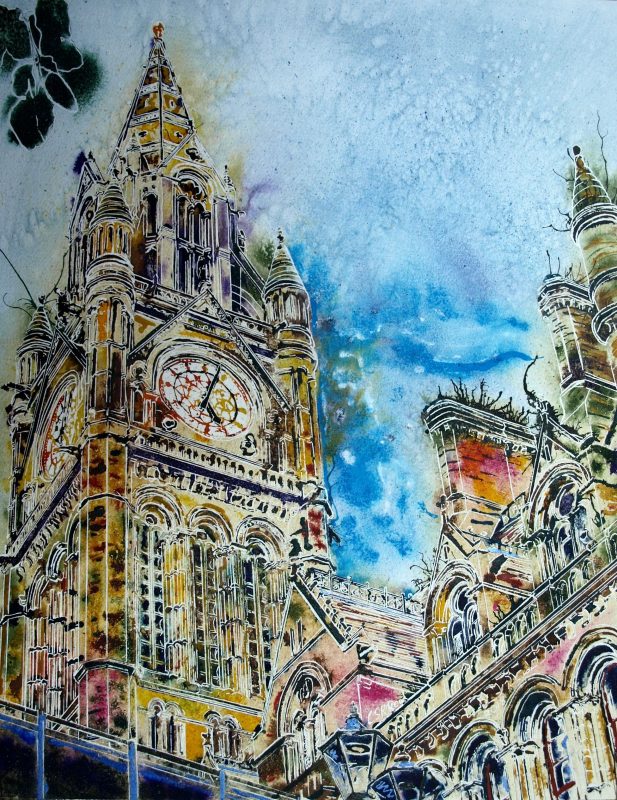Manchester – a city with a town hall? Why Manchester Town Hall, not City Hall?
Cathy Read depicts the heart of Manchester in Albert Square – one of the city’s most iconic landmarks – in glowing golden light pinks, browns, and dark greens. A small branch of a nearby tree intrudes – cheekily photo bombing, the top left of the screen.
The tower and clock face loom up the left side of the painting. The clock face glows with orange, and yellow like gold. Time is marked at 5:05 reminding us of the centuries predating this neo-Gothic masterpiece.
Manchester’s Town Hall Commissioned
Designed by Architect Alfred Waterhouse and completed in 1887. Waterhouse won the design competition for the Town Hall with just a little help from his friend, the author Elizabeth Gaskell – who asked the celebrated art critic John Ruskin to recommend Waterhouse to the council. How fortunate for us. It is doubly regarded as one of the finest examples of Neo-Gothic architecture in the United Kingdom and one of the most important Grade One listed buildings in England – well befitting of City Hall status.
The detail in the painting is almost overwhelming. Lines pack in tightly with little room for paint to explore. The triplet of windows, below the clock face, form a tight grid-like structure. Formal by the wooden baffles? A formal building that hosted prestigious guests like Prime Ministers Churchill and Lloyd George.
The rest of the Town Hall rises triumphantly to the right, with layers of windows, chimneys, and turrets. It is hard to believe that that there were plans to demolish the Town Hall in the post war clean up! Planners proposed replacing the old Sooty building with a new Town Hall in the Art Deco style. They felt the old one was no longer suitable. Fortunately, the idea was scrapped.
Humble Origins
The architectural masterpiece is now the at the heart of Manchester and literally dominates Albert Square. But it has humble origins. Should you pause at the front main entrance you will notice a statue of the Roman Governor, Agricola, founder of the original fort of Manuciam in AD79.
Modern Manchester advanced from there.
The fence stands in stark contrast to the architectural grandeur. Simple. Functional. Some would say, “Ugly!” A useful barrier kept folks at a safe distance and moving through the Square or Albert Square Market in an orderly fashion during renovations. The simplicity reminiscent of the very first functional timber and turf fort first erected by a fierce Roman Governor.
Before leaving, observe the bottom two streetlights and a fence creeping upwards into view on the painting. A decorative light is just visible, the top one of three on a pole. The last one hidden out of sight inviting us to wonder at new chapters unfolding in future.

The Heart of Manchester has sold but other paintings of Manchester Town Hall are available.
